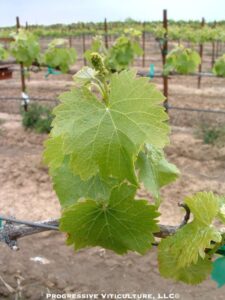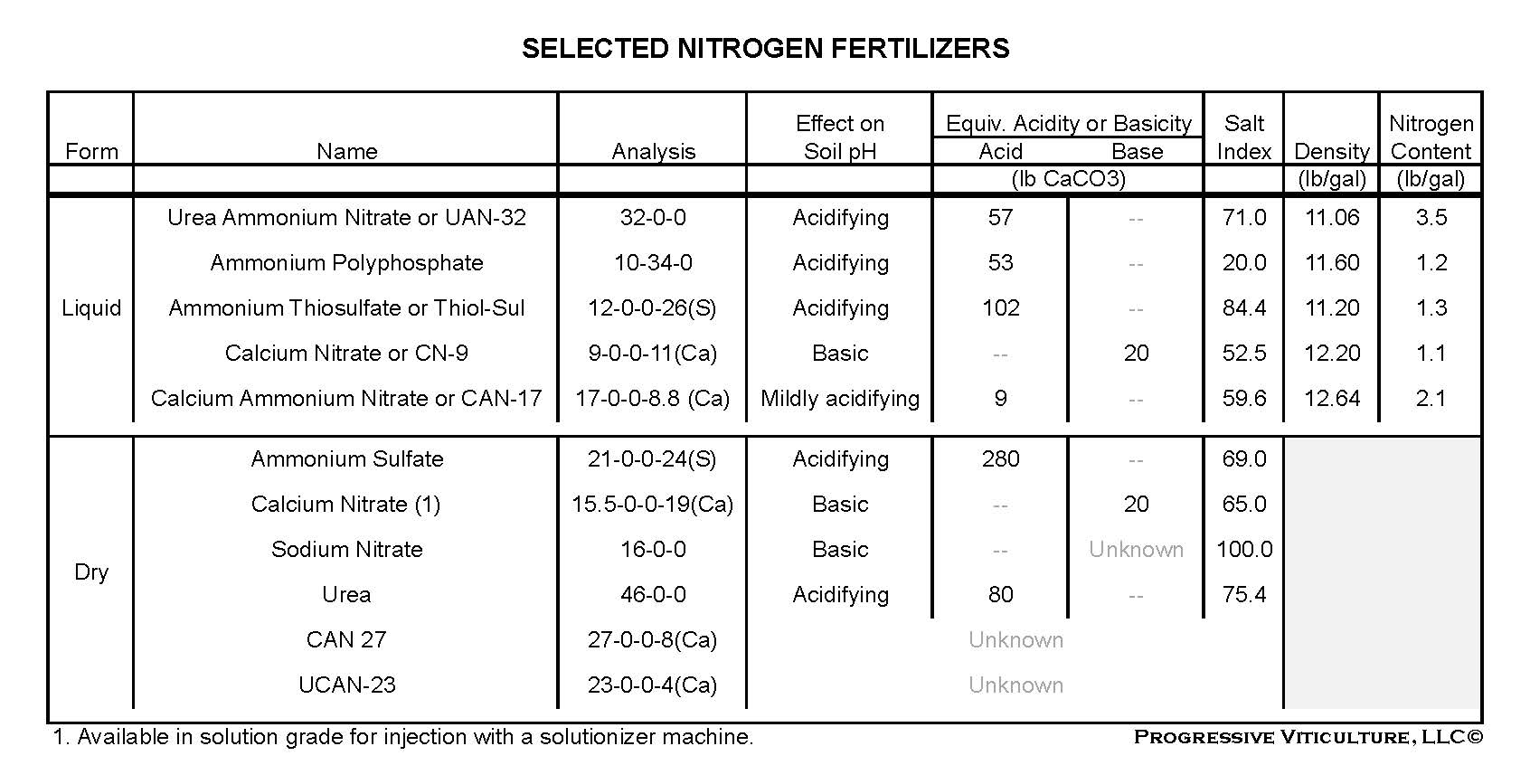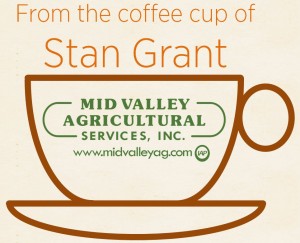 In my last Lodi Growers Coffee Shop article, we considered nitrogen’s pivotal role and impacts on grapevines. In this article, we investigate nitrogen management. As in the management of all mineral nutrients, vine nutrient demand is the place to begin development of a nitrogen management strategy.
In my last Lodi Growers Coffee Shop article, we considered nitrogen’s pivotal role and impacts on grapevines. In this article, we investigate nitrogen management. As in the management of all mineral nutrients, vine nutrient demand is the place to begin development of a nitrogen management strategy.
Seasonal Nitrogen Demand
In well-managed vineyards, the harvested fruit represents the greatest net annual nitrogen loss (fig. 1). The amount of nitrogen in mature fruit is, on the average, about 3 pounds per ton. Fruit nitrogen, or some portion of it, is usually the targeted value for total annual nitrogen fertilizer applications to vineyards. The distribution of applied fertilizer nitrogen over the course of the growing season depends on the following other factors.
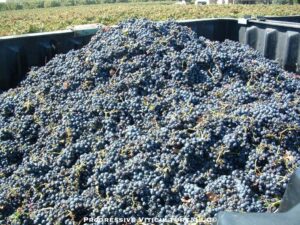
Fig. 1. For well-managed in vineyards, the harvest fruit represents the greatest N loss. Source: Progressive Viticulture, LLC ©
Early Season
During the early part of the growing season, nitrogen is required to support shoot growth and canopy development. Much of this nitrogen comes from reserves stored in the woody tissues. As a soil warms, roots become active, and developing leaves begin to transpire, vines increasingly draw upon nitrogen sources in the soil. Coincidently, during this time soil microbe numbers and activities also increase, including their conversion of organic nitrogen (amino acids, peptides, proteins, etc.) into the inorganic forms that can be taken up by vine roots.
Consequently, early in the season we have the opportunity to make good use of on-site nitrogen resources present in woody vine tissues and soil organic matter, including incorporated residues of legume rich cover crops. Often, these combined sources are sufficient to meet early season vine nitrogen demand, but in some instances they may need to be supplemented with either foliar or soil applied fertilizer. Too few internodes (< 10 to 12 by bloom), internodes shorter than 3 inches, leaves smaller than normal, and slightly pale foliage indicate the need for supplemental nitrogen (fig 2). Early in the season, apply nitrogen fertilizer only to support normal foliage growth, and cease applications in advance of bloom to avoid interferences with fruit set.
________________________________________________________________________________
This article is a reproduction of the Mid Valley Agricultural Services Viticulture Newsletter, June 2011.
________________________________________________________________________________
Mid Season
Shortly after fruit set, if everything is working well in a vineyard, the development of canopies is nearly complete (14 to 20 leaves per shoot) and shoot growth is arrested. We now turn our attention to fruit nitrogen nutrition. At this time, we have bloom tissue analysis results to aid our nitrogen management decisions. Petiole total nitrogen of 0.8% or less, especially in combination with nitrate-nitrogen (NO3-N) less than 200 ppm, indicates the need for intensified nitrogen fertilizer applications.
Even with adequate bloom tissue nitrogen, some portion of the fruit nitrogen requirement is beneficially applied after set to meet steady demand in the fruit and ensure timely ripening. During this time, nitrogen is normally applied in small doses (< 5 lb N/acre). Prior to veraison, such applications promote adequate yeast assimilable nitrogen (YAN) in the harvested fruit. After veraison they can be especially beneficial for vines with leaves damaged by pests or stresses. Because the active root zone recedes under the drip emitter some time after fruit set, fertigation is normally the most effective method for late season nitrogen fertilizer application to soils (fig 3).
Post Harvest
After harvest and prior to leaf fall, apply fertilizer nitrogen to replenish reserves in woody tissues and ensure adequate nitrogen for the beginning of the next growing season. Application rates can be somewhat liberal with little concern for adverse effects on vines, but avoid single high dose applications (> 10 to 12 lb/acre) that are low in efficiency. Never inject nitrogen at concentrations of 1000 ppm or more into drip irrigation systems to avoid toxic effects on vine tissues.
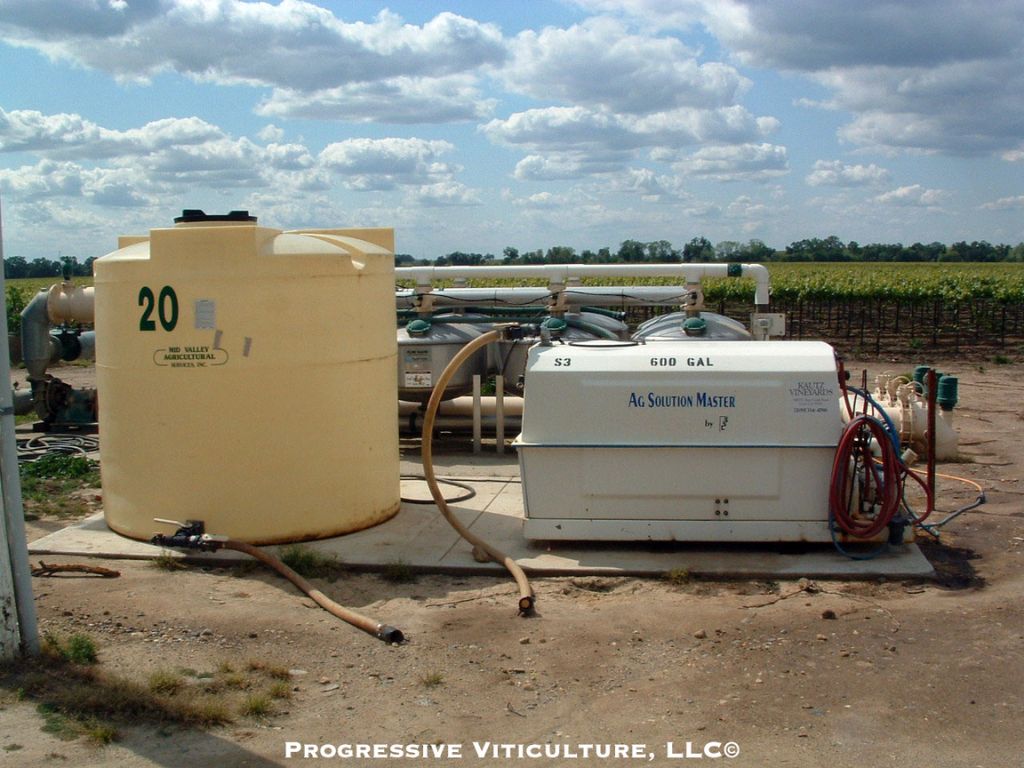
Fig. 3. Fertigation is especially effective for mid-season N applications. Source: Progressive Viticulture, LLC ©
Nitrogen Fertilizer Forms
Organic nitrogen fertilizers are commonly fish or blood meal based and the availability of the nitrogen from them depends on microbial transformation from organic to inorganic forms. The inorganic forms of fertilizer nitrogen are urea, ammonium, and nitrate (fig 4). While nitrogen in all three of these are more rapidly available than nitrogen from organic materials, urea and most ammonium undergo microbial conversion to nitrate before uptake by grapevines and therefore, they are slower acting. Of the two, urea is more slowly available than ammonium because conversion requires more steps. The conversions of urea and ammonium to nitrate are acid producing processes, which are advantageous for neutralizing alkaline soils, but detrimental to acid soils and any soil with a low buffering capacity (i.e. low CEC). Still, urea and ammonium are often the preferred N fertilizer forms for prolonged residence time in the soil.
To promote efficiency, nitrate fertilizer applications are typcially low rate, but moderate rates are useful for eliciting quick vegetative responses. Balanced fertigation programs commonly include nitrate alternated with urea and ammonium to avoid or minimize soil acidification. Mined sodium nitrate is fast acting nitrogen fertilizer for organic vineyards.
In summary, effective nitrogen management involves the proper nutrient form in the correct place, at an appropriate time, and in proportionate to the demand in grapevines and their capacity to take it up. It also assumes vines are supplied with adequate water and other mineral nutrients (e.g. boron, manganese, molybdenum), because shortages may inhibit nitrogen uptake and use.
Further Reading
- California Fertilizer Association. Western fertilizer handbook. Interstate Publishers, Danville, Illinois. (1998).
- Christensen, LP; Bianchi, ML; Peacock, WL; Hirschfelt, DJ. Effect of nitrogen fertilizer timing and rate on inorganic nitrogen status, fruit composition, and yield of grapevines. Am. J. Enol. Vitic. 45, 377. 387. 1994.
- Burt, C; O’Connor, K; Ruehr, T. Fertigation. Irrigation Training and Research Center, Calif. Poly. State Univ., San Luis Obispo, CA. (1998).
- Conradie, W. J. Seasonal uptake of nutrients by Chenin blanc in sand culture: I. Nitrogen. S. Afr. J. Enol. Vitic. 1, 59-65. (1980).
- Conradie, W. J. Utilization of nitrogen by the grapevine as affected by time of application and soil type. S. Afr. J. Enol. Vitic. 7, 76-83. (1986)
- Grant, S. Balanced soil fertility management in vineyards. Practical Winery and Vineyard. May/Jun (2002).
- Hayes, R. J. and R. S. Swift. Effect of trickle fertigation with three forms of nitrogen on soil pH, levels of extractable nutrients below the emitter and plant growth. Plant and Soil. 102, 211-221 (1987).
- Marschner, H. Mineral nutrition of higher plants. Academic Press, London. (1986).
- Miller , R. J., D. E. Rolston, R. S. Rauschkolb, and D. W. Wolfe. Drip application of nitrogen is efficient. Calif. Agric. 30, 16-18. (1976).
- Peacock, W. L., L. P. Christensen, and F. E. Broadbent. Uptake, storage, and utilization of soil-applied nitrogen by Thompson Seedless as affected by time of application. Am. J. Enol. Vitic. 40, 16-20 (1989).
- Peacock, WL; Christensen, LP; Hirschfelt, DJ. Influence of timing of nitrogen fertilizer application on grapevines in the San Joaquin Valley. Am. J. Enol. Vitic. 42, 322-326. 1991.
- Tisdale, SL; Nelson, WL; Beaton, JD. Soil fertility and fertilizers. 4th Ed. Macmillan Publishing Company, New York. (1985).

